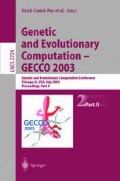Abstract
In this paper we present an approach that evolves the consensus sequence [25] for multiple sequence alignment (MSA) with genetic algorithm (GA). We have developed an encoding scheme such that the number of generations needed to find the optimal solution is approximately the same regardless the number of sequences. Instead it only depends on the length of the template and similarity between sequences. The objective function gives a sum-of-pairs (SP) score as the fitness values. We conducted some preliminary studies and compared our approach with the commonly used heuristic alignment program Clustal W. Results have shown that the GA can indeed scale and perform well.
Access this chapter
Tax calculation will be finalised at checkout
Purchases are for personal use only
Preview
Unable to display preview. Download preview PDF.
References
Altschul, S.F., Carroll, R.J., and Lipman, D. Weights for data related by a tree. Journal of Molecular Biology, 207: 647–653 (1989).
Altschul, S.F. and Lipman, D. Trees, stars, and multiple sequence alignment. SIAM Journal of Applied Mathematics, 49: 197–209 (1989).
Altschul, S.F., Gish, W., Miller, W., Myers, E. W., and Lipman, D. Basic local alignment search tool. Journal of Molecular Biology, 215(3):403–410 (1990).
Day, W.H. and McMorris, F.R. The computation of consensus patterns in DNA sequence. Mathematical and Computational Model. 17, 49–52 (1993).
Carrillo, H. and Lipman, D. The multiple sequence alignment problem in biology. SIAM Journal of Applied Mathematics, 48: 1073–1082 (1988).
Carroll, S.B., Grenier, J.K., and Weatherbee, S.D. From DNA to diversity: molecular genetics and the evolutionary of animal designs. Malden, MA: Blackwell Science (2001).
Durbin, R., Eddy, S., Krogh, A., and Mitchison, G. Biological sequence analysis: probabilistic models of proteins and nucleic acids. Cambridge, UK: Cambridge University (1998).
Fogel, D.B. and Corne, D.W. (ed.). Evolutionary Computation in Bioinformatics. San Fran-cisco, CA: Morgan Kaufmann Publishers (2003).
Feng, D. and Doolittle, R.F. Progressive sequence alignment as a prerequisite to correct phylogenetic trees. Journal of Molecular Evolutionary, 25: 351–360 (1987).
Graur, D. and Li, W.H. Fundamental of Molecular Evolution, 2nd ed. Sunderland, MA: Sinauer Associates (2000).
Wang, L., and Gusfield, D. Improved approximation algorithms for tree alignment. Journal of Algorithms, 25: 255–273 (1998)
Gusfield, D. Algorithms on strings, trees and sequences: computer science and computational biology. New York, NY: Cambridge University Press (1997).
Hall, B.G. Phylogenetics trees made easy: a how-to manual for molecular biologists. Sunderland, MA: Sinauer Associates (1997).
Needleman, S.B. and Wunsch, C.D. A general method applicable to the search for similarities in the amino acid sequence of two proteins. J. of Mol. Biol. 48: 443–453 (1970).
Sean, R.E. A memory-efficient dynamic programming algorithm for optimal alignment of sequence to an RNA secondary structure. BMC Bioinformatics, 3: 13 (2002).
Sauder, J., Arther, J., and Dunbrack, R. Large-scale of comparison of protein sequence alignment algorithms with structure alignments. Proteins: structures, function, and genetics, 40: 6–32 (2000).
Setubal, J. and Meidanis, J. Introduction to computational molecular biology. Boston, MA: PWS Publishing (1997).
Stoye, J., Perry, S.W., and Dress, A.W.M. Improving the divide-and-conquer approach to sum-of-pairs multiple sequence alignment. Applied Mathematical Literature, vol. 10, no. 2, pp. 67–73 (1997).
Thomsen, R., Fogel, G.B., and Kirnk, T. A Clustal alignment improver using evolutionary algorithms. Congress on Evolutionary Computation, vol. 1; p. 121–126 (2002).
Thompson, J.D., Higgins, D.G., and Gibson, T.J. Clustal W: improving the sensitivity of progressive multiple sequence alignment through sequence weighting, position specific gap penalties and weight matrix choice. Nucleic Acids Research, 22: 4673–4680 (1994).
Thompson, J. D., Gibson, T.J., Plewniak, F., Jeanmougin, F., and Higgins, D.G. The Clustal X windows interface: flexible strategies for multiple sequence alignment aided by quality analysis tools. Nucleic Acids Research, 24: 4876–4882 (1997).
Wang, L. and Jiang, T. On the complexity of multiple sequence alignment. Journal of Computational Biology, 1: 337–348 (1994).
Waterman, S.M. and Eggert, M. A new algorithm for best subsequence alignments with application to tRNA-rRNA comparisons. J. of Molecular Biology, 197: 723–725 (1987).
Whitley, D. A genetic algorithm tutorial. Statistics and Computing, vol. 4: 65–85 (1994).
Keith, J.M., Adams, P., Bryant, D. Kroese, D.P., Mitchelson, K.R., Cochran, D.A.E., and Lala, G.H. A simulated annealing algorithm for finding consensus sequences. Bioinformaics, vol. 18, no. 11, p. 1494–1499 (2002).
Wang, L., Jiang, T. and Gusfield, D. A more efficient approximation scheme for tree align-ment. SIAM Journal of Computational Biology. 30: 283–299 (2000).
Author information
Authors and Affiliations
Editor information
Editors and Affiliations
Rights and permissions
Copyright information
© 2003 Springer-Verlag Berlin Heidelberg
About this paper
Cite this paper
Shyu, C., Foster, J.A. (2003). Evolving Consensus Sequence for Multiple Sequence Alignment with a Genetic Algorithm. In: Cantú-Paz, E., et al. Genetic and Evolutionary Computation — GECCO 2003. GECCO 2003. Lecture Notes in Computer Science, vol 2724. Springer, Berlin, Heidelberg. https://doi.org/10.1007/3-540-45110-2_124
Download citation
DOI: https://doi.org/10.1007/3-540-45110-2_124
Published:
Publisher Name: Springer, Berlin, Heidelberg
Print ISBN: 978-3-540-40603-7
Online ISBN: 978-3-540-45110-5
eBook Packages: Springer Book Archive

